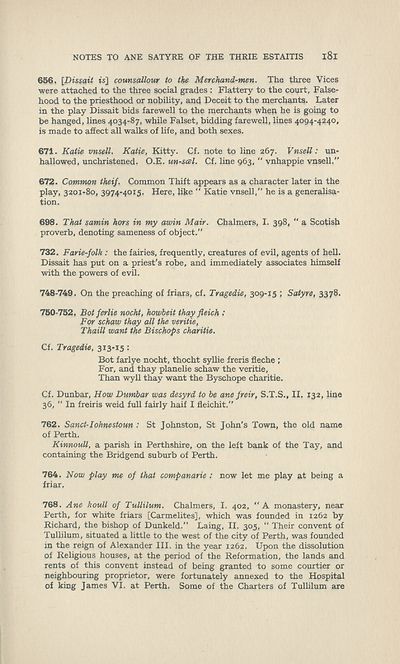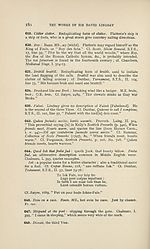Scottish Text Society publications > Third series > Works of Sir David Lindsay of the Mount, 1490-1555 > Volume 4, 1936
(249)
Download files
Complete book:
Individual page:
Thumbnail gallery: Grid view | List view

NOTES TO ANE SATYRE OF THE THRIE ESTAITIS l8l
656. [Dissait ts] counsallour to the Merchand-men. The three Vices
were attached to the three social grades : Flattery to the court. False¬
hood to the priesthood or nobility, and Deceit to the merchants. Later
in the play Dissait bids farewell to the merchants when he is going to
be hanged, lines 4034-87, while Falset, bidding farewell, lines 4094-4240,
is made to affect all walks of life, and both sexes.
671. Katie vnsell. Katie, Kitty. Cf. note to line 267. Vnsell: un¬
hallowed, unchristened. O.E. un-scel. Cf. line 963, “ vnhappie vnsell.”
672. Common theif. Common Thift appears as a character later in the
play, 3201-80, 3974-4015. Here, like " Katie vnsell,” he is a generalisa¬
tion.
698. That samin hors in my awin Mair. Chalmers, I. 398, " a Scotish
proverb, denoting sameness of object."
732. Fane-folk : the fairies, frequently, creatures of evil, agents of hell.
Dissait has put on a priest’s robe, and immediately associates himself
with the powers of evil.
748-749. On the preaching of friars, cf. Tragedie, 309-15 ; Satyre, 3378.
750-752. Bot ferlie nocht, howbeit thay fleich :
For schaw thay all the veritie,
Thaill want the Bischops charitie.
Cf. Tragedie, 313-15 :
Bot farlye nocht, thocht syllie freris fleche ;
For, and thay planelie schaw the veritie,
Than wyll thay want the Byschope charitie.
Cf. Dunbar, How Dumbar was desyrd to be ane freir, S.T.S., II. 132, line
36, " In freiris weid full fairly half I fleichit.”
762. Sanct-Iohnestoun : St Johnston, St John’s Town, the old name
of Perth.
Kinnoull, a parish in Perthshire, on the left bank of the Tay, and
containing the Bridgend suburb of Perth.
764. Now play me of that companarie : now let me play at being a
friar.
768. Ane koull of Tullilum. Chalmers, I. 402, “A monastery, near
Perth, for white friars [Carmelites], which was founded in 1262 by
Richard, the bishop of Dunkeld." Laing, II. 305, “ Their convent of
Tullilum, situated a little to the west of the city of Perth, was founded
in the reign of Alexander III. in the year 1262. Upon the dissolution
of Religious houses, at the period of the Reformation, the lands and
rents of this convent instead of being granted to some courtier or
neighbouring proprietor, were fortunately annexed to the Hospital
of king James VI. at Perth. Some of the Charters of Tullilum are
656. [Dissait ts] counsallour to the Merchand-men. The three Vices
were attached to the three social grades : Flattery to the court. False¬
hood to the priesthood or nobility, and Deceit to the merchants. Later
in the play Dissait bids farewell to the merchants when he is going to
be hanged, lines 4034-87, while Falset, bidding farewell, lines 4094-4240,
is made to affect all walks of life, and both sexes.
671. Katie vnsell. Katie, Kitty. Cf. note to line 267. Vnsell: un¬
hallowed, unchristened. O.E. un-scel. Cf. line 963, “ vnhappie vnsell.”
672. Common theif. Common Thift appears as a character later in the
play, 3201-80, 3974-4015. Here, like " Katie vnsell,” he is a generalisa¬
tion.
698. That samin hors in my awin Mair. Chalmers, I. 398, " a Scotish
proverb, denoting sameness of object."
732. Fane-folk : the fairies, frequently, creatures of evil, agents of hell.
Dissait has put on a priest’s robe, and immediately associates himself
with the powers of evil.
748-749. On the preaching of friars, cf. Tragedie, 309-15 ; Satyre, 3378.
750-752. Bot ferlie nocht, howbeit thay fleich :
For schaw thay all the veritie,
Thaill want the Bischops charitie.
Cf. Tragedie, 313-15 :
Bot farlye nocht, thocht syllie freris fleche ;
For, and thay planelie schaw the veritie,
Than wyll thay want the Byschope charitie.
Cf. Dunbar, How Dumbar was desyrd to be ane freir, S.T.S., II. 132, line
36, " In freiris weid full fairly half I fleichit.”
762. Sanct-Iohnestoun : St Johnston, St John’s Town, the old name
of Perth.
Kinnoull, a parish in Perthshire, on the left bank of the Tay, and
containing the Bridgend suburb of Perth.
764. Now play me of that companarie : now let me play at being a
friar.
768. Ane koull of Tullilum. Chalmers, I. 402, “A monastery, near
Perth, for white friars [Carmelites], which was founded in 1262 by
Richard, the bishop of Dunkeld." Laing, II. 305, “ Their convent of
Tullilum, situated a little to the west of the city of Perth, was founded
in the reign of Alexander III. in the year 1262. Upon the dissolution
of Religious houses, at the period of the Reformation, the lands and
rents of this convent instead of being granted to some courtier or
neighbouring proprietor, were fortunately annexed to the Hospital
of king James VI. at Perth. Some of the Charters of Tullilum are
Set display mode to: Large image | Zoom image | Transcription
Images and transcriptions on this page, including medium image downloads, may be used under the Creative Commons Attribution 4.0 International Licence unless otherwise stated. ![]()
| Publications by Scottish clubs > Scottish Text Society publications > Third series > Works of Sir David Lindsay of the Mount, 1490-1555 > Volume 4, 1936 > (249) |
|---|
| Permanent URL | https://digital.nls.uk/107277863 |
|---|
| Shelfmark | SCS.STES3.8 |
|---|---|
| Attribution and copyright: |
|
| Description | A collection of over 100 Scottish texts dating from around 1400 to 1700. Most titles are in Scots, and include editions of poetry, drama, and prose by major Scottish writers such as John Barbour, William Dunbar, Gavin Douglas, and George Buchanan. Edited by a key scholarly publisher of Scotland's literary history, and published from the late 19th century onwards by the Scottish Text Society. Available here are STS series 1-3. |
|---|

